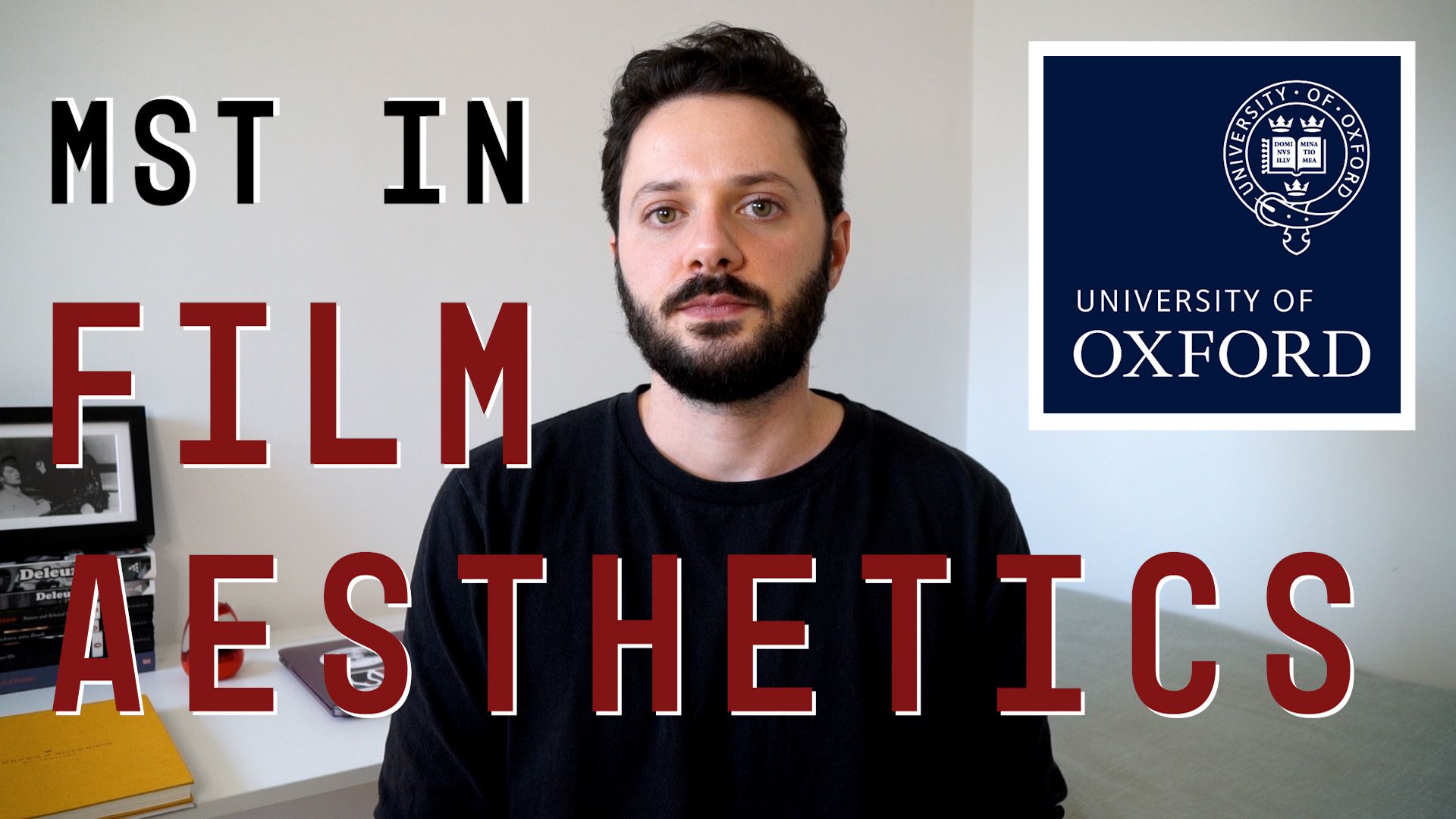Studying Film Aesthetics at the University of Oxford
In this article, I discuss my experience with studying the MSt in Film Aesthetics at the University of Oxford, and address some of the most common questions that have come my way from potential applicants.

Hi, my name is Zach.
Back in August 2020, I graduated from the University of Oxford with a MSt in Film Aesthetics. Since then, a number of people interested in applying have reached out to me asking about my experience so I thought I’d write an article that discusses this experience and addresses the most common questions that have come my way.
The Programme
If you are interested in applying to the programme I would definitely recommend going to the course page and reading that thoroughly first. On that page, you can learn more about what the course covers, what it doesn’t cover, and how the course is structured. But, to summarise, the MSt in Film Aesthetics is dedicated to the specialist study of form, and film as an art form. As per the course description, the programme focuses on ‘film criticism, detailed film analysis, film theory and philosophy insofar as they relate to film aesthetics.’ It is worth mentioning here, because I get asked this a lot, that the course isn’t a practical one, and doesn’t teach film production – it’s completely theoretical.
It’s also worth mentioning that the programme is an interdisciplinary degree meaning that it is run by three different faculties in the Humanities: English, Modern Languages, and Philosophy – with the majority of the modules taught through Modern Languages. This therefore means that there isn’t a centralised film studies department. There are various advantages and disadvantages to this. For example:
+ The advantage of not having a centralised film studies department is that it does allow more overlap with other disciplines. The majority of the lecturers on the course come from a language background, especially French. Some lecturers do have a background in film studies, and the ones that don’t have still published books on film and are leading academics in the field.
– However, the disadvantage of not having a centralised film studies department is that the modules do tend to be demarcated by language i.e. the modules with a lecturer of French will tend to focus on French films and theorists. This is not necessarily a bad thing, but it does slightly limit what can be studied to a certain extent.
These are up to you to weigh up if you are considering applying.
Programme Structure
The programme runs over 9-months or one academic year. At Oxford there are three terms: the first term is called Michaelmas, the second is called Hilary, and the third is called Trinity. The first two of these terms consist of seminars and screenings. In the first term, my cohort studied three modules: The Aesthetic Evaluation of Film, The Study of a Director (which for the past few years has been Rainer Werner Fassbinder), and Concepts in Film History: The Face, which looked at the face in film and Gilles Deleuze’s cinema books. This could change in the future so again the course webpage is the first resource I would recommend you check for the most up to date information. Most of my classes were held in either the English Faculty or St Anne’s college, with all of the screenings held at St Anne’s as well. There is a good chance that these locations will continue to be used as part of the course.
In the second term, the structure of the course changes slightly. This term consists of four modules that last two weeks each and, as you rotate through each one, make up the 8-week term altogether. These modules are subject to change each year, but the ones that I did were:
1) Individuation in Technology and Natural Environments with Professor Nikolaj Lübecker
2) Stanley Cavell’s Philosophy of Film with Professor Stephen Mulhall
3) Art in Film with Dr Rey Conquer
4) The Aesthetics of Italian Cinema with Professor Guido Bonsaver
Other examples of what might be on offer are included on the course webpage so, again, I would recommend checking that out. Finally, Trinity term is entirely independent study and contains no contact hours aside from meetings with your dissertation supervisor.
Assignments
There are 4 different assignments: 2 longer essays of 6,000 words, 1 shorter essay of 3,000 words, and the final dissertation of 10,000 words.
The final versions of all these assignments are due at various points towards the end of the final term, Trinity. However, you write the first draft of one of the longer essays during the winter break after the first term, the first draft of the second longer essay during the Easter break after the second term. Both of these drafts are submitted to be reviewed by the course convenors, Andrew Klevan and Reidar Due, and feedback will be provided with a predicted grade.
The dissertation and shorter essay are written during Trinity term. The dissertation is written in consultation with your supervisor, whereas the shorter essay is written without any feedback system in place. During this final term, there is also the opportunity to edit the two longer essays before the final submission.
Colleges
Oxford is a collegiate research university, meaning that the University is comprised of various independently run colleges. As part of your application to the programme you have the option of selecting your preferred college. If you don’t declare a preference, you will be allocated to a college by the University. There is a list of colleges that accept Film Aesthetics students included on the course webpage. Unlike undergraduate study at Oxford, your classes will not solely be held within the college that you apply to and not everyone on the course will be at the same college. Instead, the course teaching takes place in various colleges and faculties, which is usually dependant on who your tutor is, and the college/faculty they belong to.
When choosing a college as a postgraduate student you might want to consider the type of accommodation on offer, the facilities that the college provides, the location, the age of the college, if the college provides any postgraduate scholarships, and perhaps any extracurricular activities the college might be known for. St Anne’s college especially welcomes Film Aesthetics students, and their college library contained the most books included on the syllabus.
Common Questions
To conclude this article, I’ll go over a few of the common questions I’ve received so far, and hopefully that will be of some use to any potential applicants that may be reading.
1) Is the course practical?
No, the course is entirely theoretical, and all of the assignments are written.
That being said, there is a week-long filmmaking workshop that precedes the start of the course, but this is not actually part of the programme and is not assessed. As per the course website: ‘Although the degree itself is not practical, this week acts as an introduction to film techniques and allows the group to work with each other before the degree begins.’
If you want to get involved in filmmaking alongside the course, there are opportunities to do so through student-run clubs like the Oxford University Film Foundation.
2) What is the workload like?
In my experience, the schedule of the course itself was quite manageable. There aren’t that many contact hours. However, there is a lot of reading and independent study to do and that took up most of my time outside of class. Which leads to the next question:
3) How much reading exactly?
There is a lot of reading to do each week. It can vary week to week from around 200 pages at the lower end to close to 3-400 pages at the upper end, not including the further suggested readings. Naturally, it is also recommended that you watch films in addition to the ones included on the course syllabus.
4) Other benefits of course?
There are a lot of events that Oxford and its individual colleges run that are a unique part of studying at the University. It can start to get a bit overwhelming trying to manage both these events and study, but at the end of the day it’s up to you how much time you want to dedicate to each commitment.
In addition to this, there is the obvious benefit that you would be studying at the oldest university in the English-speaking world, with one of the oldest libraries in Europe that, in Britain, is second in size only to the British Library in London––and you’d be doing all this under leading academics in the field of film studies.
5) Would I recommend it?
I’d recommend the course if you have a specific interest in film aesthetics and film-philosophy, especially if you intend to pursue further tertiary study in film, such as a PhD. It will not assist in gaining industry experience, and there was no real opportunity to foster links with industry, so it might not be ideal if that is your goal afterwards. If you want to go into a job that involves writing about art/culture/film for a magazine or organisation then I would imagine this would help out with that.
On the topic of potential graduate destinations, the course website mentions that the 'analytical skills taught in the course are applicable in a wide range of jobs concerned with film and visual media, for example film programming, film reviewing, film production, design and teaching. The course is especially suitable as a foundation for further scholarly research into film'.
Conclusion
With all that being said, I hope this article clarified some of the queries any potential applicants might have. If you would like to watch the video version of this article, you can do so below. Alternatively, you can also watch this video, along with others on similar topics, at the Cinema Scholar YouTube channel.
Course Links and Further Advice
Advice on Applying to a MSt at Oxford in the Humanities:

